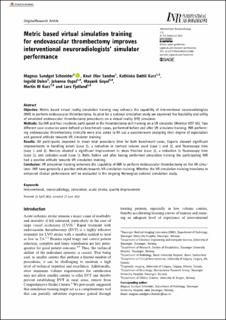| dc.contributor.author | Schneider, Magnus Sundgot | |
| dc.contributor.author | Sandve, Knut Olav Lende | |
| dc.contributor.author | Kurz, Kathinka Dæhli | |
| dc.contributor.author | Dalen, Ingvild | |
| dc.contributor.author | Ospel, Johanna | |
| dc.contributor.author | Goyal, Mayank | |
| dc.contributor.author | Kurz, Friedrich Martin Wilhelm | |
| dc.contributor.author | Fjetland, Lars | |
| dc.date.accessioned | 2023-03-16T13:49:20Z | |
| dc.date.available | 2023-03-16T13:49:20Z | |
| dc.date.created | 2022-08-11T13:42:58Z | |
| dc.date.issued | 2022 | |
| dc.identifier.citation | Schneider, M. S., Sandve, K. O., Kurz, K. D., Dalen, I., Ospel, J., Goyal, M., ... & Fjetland, L. (2022). Metric based virtual simulation training for endovascular thrombectomy improves interventional neuroradiologists’ simulator performance. Interventional Neuroradiology, 15910199221113902. | en_US |
| dc.identifier.issn | 1591-0199 | |
| dc.identifier.uri | https://hdl.handle.net/11250/3058855 | |
| dc.description.abstract | Objective
Metric based virtual reality simulation training may enhance the capability of interventional neuroradiologists (INR) to perform endovascular thrombectomy. As pilot for a national simulation study we examined the feasibility and utility of simulated endovascular thrombectomy procedures on a virtual reality (VR) simulator.
Methods
Six INR and four residents participated in the thrombectomy skill training on a VR simulator (Mentice VIST 5G). Two different case-scenarios were defined as benchmark-cases, performed before and after VR simulator training. INR performing endovascular thrombectomy clinically were also asked to fill out a questionnaire analyzing their degree of expectation and general attitude towards VR simulator training.
Results
All participants improved in mean total procedure time for both benchmark-cases. Experts showed significant improvements in handling errors (case 2), a reduction in contrast volume used (case 1 and 2), and fluoroscopy time (case 1 and 2). Novices showed a significant improvement in steps finished (case 2), a reduction in fluoroscopy time (case 1), and radiation used (case 1). Both, before and after having performed simulation training the participating INR had a positive attitude towards VR simulation training.
Conclusion
VR simulation training enhances the capability of INR to perform endovascular thrombectomy on the VR simulator. INR have generally a positive attitude towards VR simulation training. Whether the VR simulation training translates to enhanced clinical performance will be evaluated in the ongoing Norwegian national simulation study. | en_US |
| dc.language.iso | eng | en_US |
| dc.publisher | Sage | en_US |
| dc.rights | Navngivelse 4.0 Internasjonal | * |
| dc.rights.uri | http://creativecommons.org/licenses/by/4.0/deed.no | * |
| dc.title | Metric based virtual simulation training for endovascular thrombectomy improves interventional neuroradiologists’ simulator performance | en_US |
| dc.type | Peer reviewed | en_US |
| dc.type | Journal article | en_US |
| dc.description.version | publishedVersion | en_US |
| dc.rights.holder | The authors | en_US |
| dc.subject.nsi | VDP::Medisinske Fag: 700 | en_US |
| dc.source.pagenumber | 1-6 | en_US |
| dc.source.journal | Interventional Neuroradiology | en_US |
| dc.identifier.doi | 10.1177/15910199221113902 | |
| dc.identifier.cristin | 2042441 | |
| cristin.ispublished | true | |
| cristin.fulltext | original | |
| cristin.qualitycode | 1 | |

